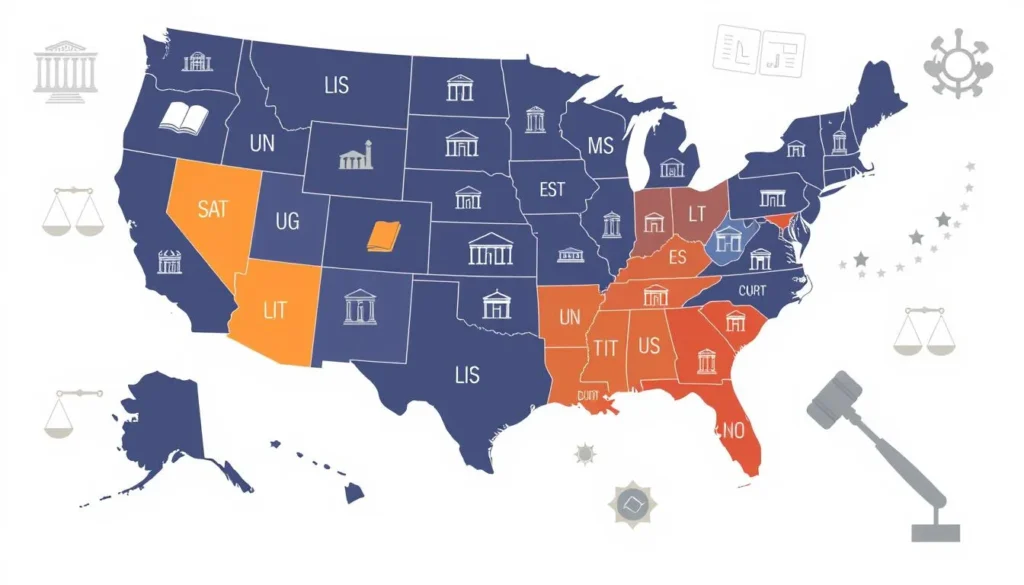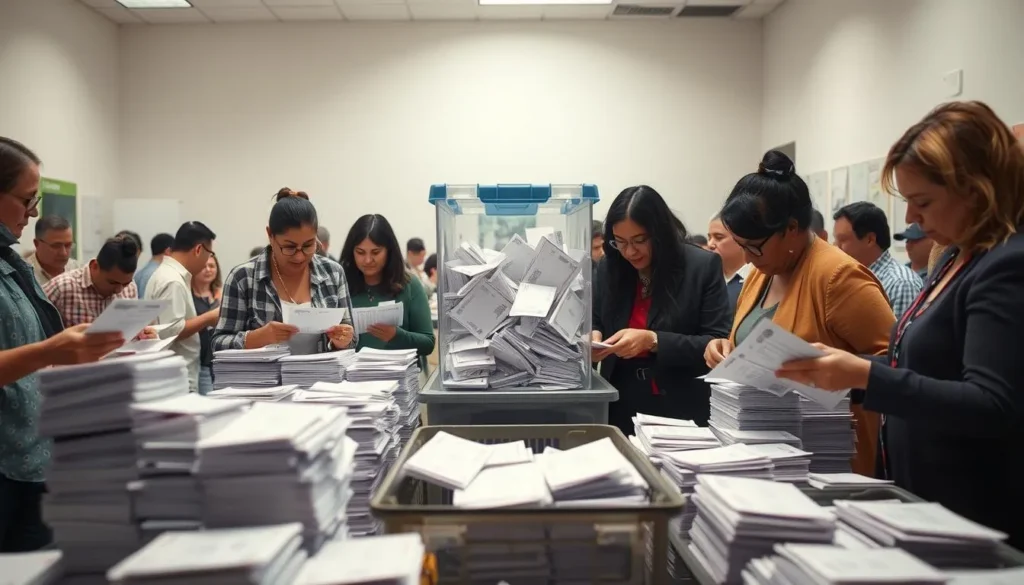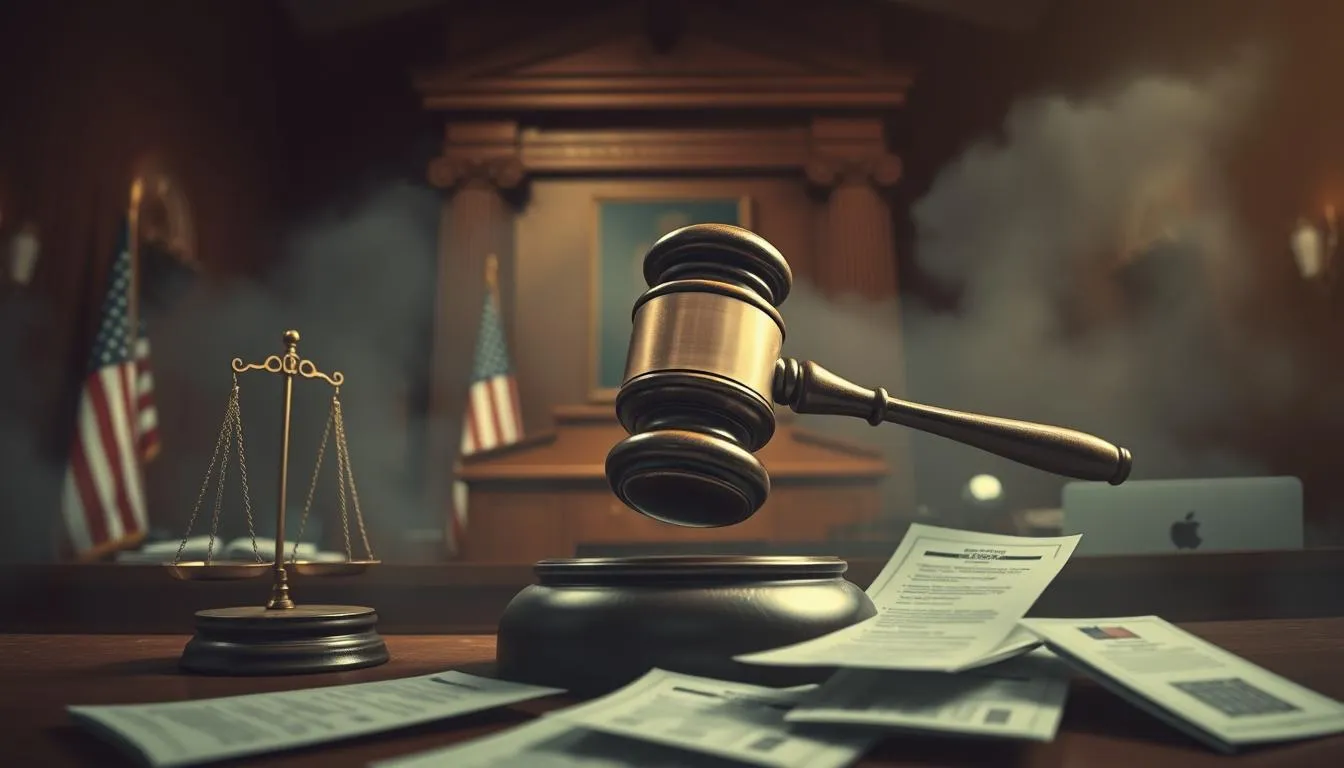After the 2020 US presidential election, over 60 legal challenges were filed. They questioned the fairness of the electoral process. Claims of voter fraud and irregularities sparked a lot of controversy, making people wonder about American democracy’s strength.
As the nation deals with the aftermath, it’s important to know about the main legal fights. These have shaped the post-election scene.
This guide will explore the complex world of US election lawsuits. You’ll learn about the historical background, key players, and legal frameworks. It will help you understand the legal battles that have caught everyone’s attention.
From challenges in battleground states to constitutional issues, you’ll get a better grasp of the legal landscape. It’s a crucial part of the nation’s story.
Key Takeaways
The 2020 US presidential election saw an unprecedented number of legal challenges related to voter fraud and electoral integrity.
- These lawsuits have raised critical questions about the strength of American democracy and the robustness of electoral processes.
- Understanding the historical context, key players, and legal frameworks is essential to navigate the complex landscape of US election lawsuits.
- The outcome of these legal battles could have significant implications for future electoral processes and the public’s trust in the democratic system.
- Evaluating the evidence and legal merits of these challenges is crucial in order to separate fact from fiction and ensure the integrity of the electoral process.
Understanding the Landscape of US Election Lawsuits
The 2020 US presidential election lawsuits were huge and complex. To understand the trump legal battles and biden victory challenges, we need to look at the past and the laws that guide post-election litigation.
Historical Context of Election Legal Challenges
US election lawsuits have a long history. They started early in the country’s history. Issues like who can vote and how votes are counted have shaped election laws. These early cases set the stage for the big cases we see today.
Key Players and Stakeholders
The 2020 election lawsuits involved many groups. This included presidential campaigns, election officials, civil rights groups, and individuals. Knowing what each side wanted helps us understand the complex legal battles after the election.
Constitutional Framework
The US Constitution gives states most power over federal elections, with the federal government playing a small role.
- The Fourteenth Amendment’s equal protection clause is key in many election lawsuits.
- The First Amendment’s free speech and association protections are also important in campaign finance and voter suppression cases.
- Looking at the history, key players, and laws helps us understand the legal battles after the 2020 election.
“The right to vote is the crown jewel of American liberties, and we will not see its luster diminished.”
Major Battleground State Challenges
The 2020 US presidential election was very close. Several battleground states were key to the outcome. After the election, irregularity allegations and state lawsuits were filed. These challenged the electoral process in these states. Let’s look at the major legal battles in some key battleground states.
Pennsylvania
Pennsylvania was a hot spot. The Trump campaign and its allies claimed issues with mail-in ballots and recounts. Some of these claims were thrown out, but the disputes went on for a while.
Georgia
Georgia was also under the microscope. The Trump campaign and Republicans raised concerns about voter irregularities and recounts. Even though Joe Biden won, the legal fights over Georgia’s election kept going.
Michigan
In Michigan, the Trump campaign and its supporters claimed ballot counting and voter fraud issues. These state lawsuits aimed to challenge the election results. But, most were rejected by the courts.
| Battleground State | Key Legal Challenges | Outcome |
|---|---|---|
| Pennsylvania | Allegations of mail-in ballot issues, recounts | Some challenges dismissed, disputes continued |
| Georgia | Voter irregularities, calls for recounts | Election results certified, legal battles ongoing |
| Michigan | Ballot counting, voter fraud allegations | Most lawsuits dismissed by courts |
These legal fights in key battleground states were a big part of the post-election scene. Both sides tried to challenge the results and ensure the electoral process was fair. The results of these state lawsuits and recounts were crucial in shaping the final election outcome.
Legal Basis for Election Result Disputes
Understanding the legal basis of US election disputes is key. This section explores important factors like standing, burden of proof, and constitutional implications. These elements shape the landscape of these critical disputes.
Standing Requirements
The legal principle of standing is crucial. It decides who can sue over election results. To sue, plaintiffs must show a direct harm or injury. This is a big challenge for those claiming voter fraud claims or election integrity issues.
Courts often require a specific, personal injury. A general interest in the election process is not enough.
Burden of Proof Standards
The burden of proof is another key factor. In election disputes, plaintiffs face a high bar. They must provide clear, convincing evidence of irregularities or errors.
Ballot audits and forensic analyses are often crucial. They help meet the evidentiary threshold.
Constitutional Considerations
Constitutional principles are at the heart of these disputes. The Constitution gives states a lot of power over elections. But federal courts also play a big role in ensuring the democratic process is fair.
Managing the balance between state and federal jurisdiction is a major challenge in election-related lawsuits.
“The right of citizens to vote is the foundation of our democratic system, and courts have a responsibility to safeguard this fundamental right.” – Voting Rights Expert
State-by-State Analysis of Voter Fraud Claims
The 2020 US presidential election was highly contested. Many allegations of voter fraud and irregularities were made across states. Some claims were proven, while others were dismissed for lack of evidence. Let’s examine the claims in key battleground states and the legal challenges they faced.
Pennsylvania: Allegations of Ballot Tampering
In Pennsylvania, the Trump campaign and allies claimed election officials mishandled mail-in ballots. But courts found no evidence to support these irregularity allegations or election integrity violations.
Georgia: Scrutinizing Signature Verification
In Georgia, the Trump campaign and supporters said signature verification was flawed. This led to counting invalid ballots. State lawsuits were initially successful but later dismissed for lack of evidence.
Arizona: Disputing Vote Tabulation
Arizona was another battleground where the Trump campaign questioned vote tabulation. They filed state lawsuits over mail-in ballot signature verification. But courts rejected these claims.
Across the country, courts have thoroughly examined irregularity allegations and state lawsuits from the 2020 election. While some claims were found valid, most were dismissed for lack of evidence.

The legal battles over these voter fraud claims have greatly affected the election certification process. As we move forward, it’s vital to keep our electoral system transparent and accountable. This ensures democracy’s core principles are upheld.
Role of Federal Courts in Election Disputes
The and have highlighted the role of federal courts, especially the Supreme Court. They are key in solving post-election disputes. It’s important to know the appeal process and the legal precedents from landmark cases.
Supreme Court Involvement
The Supreme Court is crucial in election disputes, often being the last word. They deal with voting procedures and ballot counting issues. Their decisions affect the electoral process greatly.
Appeals Process Overview
- Lawsuits start in federal district courts, where first decisions are made.
- If unhappy, parties can appeal to the federal circuit court of appeals.
- Important cases might go to the Supreme Court, which decides if to review.
Precedent-Setting Cases
Some Supreme Court decisions have set key legal precedents for election disputes. These cases cover standing, proof, and constitutional rights. Bush v. Gore, for instance, decided the 2000 presidential election.
| Case | Key Outcome |
|---|---|
| Bush v. Gore (2000) | Halted the Florida recount, effectively deciding the 2000 presidential election |
| Shelby County v. Holder (2013) | Struck down a key provision of the Voting Rights Act, impacting federal oversight of state election laws |
| Rucho v. Common Cause (2019) | Ruled that federal courts cannot hear challenges to partisan gerrymandering, leaving it to the political process |
“The courts play a crucial role in safeguarding the integrity of our elections, but they must also be mindful of the delicate balance between judicial intervention and the democratic process.”
Ballot Counting Procedures and Legal Standards
After a US election, how votes are counted and the laws that guide this process are key. This part explores the details of recounts, ballot audits, and the laws that rule these critical steps in democracy.
Recounts happen when the winning margin is very small. Each state has its own rules for when a recount is needed. These rules help make sure the first count was correct and fix any issues.
Ballot audits, however, check a random sample of votes to confirm the election’s results. There are different types of audits, like risk-limiting audits, which check if the results could be wrong. These audits help people trust that the election was fair.
- Recounts: Detailed re-tallying of votes to verify the initial count
- Ballot Audits: Systematic review of a sample of ballots to assess accuracy
- Legal Standards: State-specific laws and regulations governing these processes
| Process | Purpose | Legal Requirements |
|---|---|---|
| Recounts | Verify the accuracy of the initial vote count | Vary by state, often triggered by a narrow margin of victory |
| Ballot Audits | Assess the overall accuracy of the election results | Mandated by state laws, with various audit methods used |
These ballot counting procedures and legal standards have faced a lot of attention and lawsuits in recent US elections. Knowing how these steps work is important for keeping trust in democracy and ensuring fair elections.

Timeline of Post-Election Litigation
The 2020 US presidential election led to many legal battles. These challenges were fought in courts across the country. A timeline of key decisions, dismissals, and successful challenges has emerged.
Key Court Decisions
Right after the election, the Trump campaign and its allies filed many lawsuits. They claimed there were irregularities and wanted to change the results. But courts, including the Supreme Court, mostly said no, citing lack of evidence or standing.
Notable Dismissals
- In Pennsylvania, a federal judge tossed out a Trump campaign lawsuit. The judge said there was no evidence of widespread voter fraud.
- The Supreme Court also rejected a Texas lawsuit. Texas had no right to challenge how other states voted.
- Courts in Michigan, Georgia, and Arizona dismissed similar lawsuits. Judges found no proof of fraud or irregularities.
Successful Challenges
While most lawsuits failed, some did lead to changes. In Pennsylvania, the Supreme Court said mail-in ballots after Election Day couldn’t be counted. This decision had a small impact on the results.
The timeline shows the US electoral system’s strength. It also shows the courts’ dedication to the law, even with tough challenges.
| Date | Event | Outcome |
|---|---|---|
| November 7, 2020 | Pennsylvania lawsuit dismissed | Lack of evidence of widespread voter fraud |
| December 11, 2020 | Texas v. Pennsylvania Supreme Court rejection | Texas lacked standing to challenge other states’ voting procedures |
| December 14, 2020 | Michigan lawsuit dismissed | Allegations of irregularities unsubstantiated |
Impact on Election Certification Process
The biden victory challenges and legal fights over the 2020 US election have greatly affected the certification of election results. At both state and federal levels, the process has seen delays and controversies. This is due to state lawsuits questioning the election integrity.
In key battleground states, the certification of results was delayed. Courts looked into the evidence and arguments from the Trump campaign and its supporters. This long process left voters and the public unsure, raising questions about the electoral system’s stability and reliability.
- Delays in state-level certification caused ripple effects, hampering the transition process and fueling doubts about the legitimacy of the biden victory.
- Legal challenges and recounts in states like Georgia, Michigan, and Pennsylvania added to the complexity and drawn-out nature of the certification process.
- The involvement of the Supreme Court in some election integrity cases further underscored the high-stakes nature of these disputes.
The long-term effects of these biden victory challenges and state lawsuits on the electoral process are still unclear. The intense scrutiny and legal battles have shaken public confidence in US elections. This will likely influence future electoral reforms and debates.
“The certification process has become a battleground in itself, with each side fighting to shape the narrative and influence the outcome.”
As the nation deals with the aftermath of the 2020 election, the impact on the certification process is a critical issue. It will continue to shape American democracy’s landscape.
Legal Teams and Strategic Approaches
The 2020 US presidential election saw a record number of legal challenges. The Trump campaign and its allies filed many lawsuits to dispute the results. A team of skilled lawyers used different strategies to tackle the complex election laws.
Campaign Legal Strategies
The Trump campaign mainly argued about voter fraud and irregularities in key states. Rudy Giuliani and Jenna Ellis led the legal team. They challenged mail-in ballots, counting processes, and access to ballots.
The Biden campaign took a different path. They had a team of election law experts to protect the electoral process. Their goal was to uphold the voters’ will and ensure a peaceful transition, facing the trump legal battles and voter fraud claims.
State Attorney Responses
State attorneys general were also key in the election’s legal battles. Some, like Texas’s attorney general, supported the Trump campaign’s challenges. Others, like Michigan and Pennsylvania’s attorneys general, defended their states’ election results.
The role of state attorneys general shows the complex relationship between federal and state laws. Their actions reflect the political divisions after the election. The strategies of these players will influence the election’s outcome and the future of US elections.
Evidence Standards in Election Cases
When people say there’s voter fraud or electoral irregularities, the law is strict. Courts need strong, clear evidence, not just guesses or stories. It’s hard to prove voter fraud claims or ballot audits because election systems are made to keep votes safe.
One big challenge is “standing.” This means plaintiffs must show they were directly affected. They can’t just say they’re upset. This rule makes it tough to challenge election results.
| Evidentiary Requirement | Description |
|---|---|
| Concrete, Tangible Proof | Courts demand solid, objective evidence – not just hypothetical scenarios or unsubstantiated claims. |
| Causal Connection | Litigants must demonstrate a direct link between the alleged irregularity and the disputed election outcome. |
| Quantifiable Impact | The evidence must show the claimed irregularities were significant enough to have altered the final vote tally. |
Dealing with election disputes is complex and tough. To win, litigants need a strong, evidence-based case. If they fail, their claims might be thrown out. This shows how crucial solid evidence is in these critical legal fights.
“The burden of proof in election cases is on the party challenging the results, and they must show by clear and convincing evidence that the outcome would have been different absent the alleged irregularities.”
Media Coverage and Public Perception
The 2020 US election lawsuits have gotten a lot of media attention. This has shaped how people see the fairness of elections. News outlets have covered the lawsuits filed by the Trump campaign and its supporters.
They’ve looked at the legal arguments, court decisions, and what these mean for democracy. This coverage has likely changed how voters see the election’s legitimacy. Some worry about possible election problems, while others see the lawsuits as political attempts to challenge the election’s outcome.
These different views, often seen through political lenses, have left many unsure about the election’s fairness. Understanding the legal issues, evidence of fraud, and election history in the US is key. By looking at trusted and unbiased sources, you can better understand the lawsuits and their effect on people’s trust in elections.
FAQ
What is the legal basis for contesting election results in the United States?
In the U.S., contesting election results is based on the Constitution and state and federal laws. To challenge an election, a plaintiff must show they have a right to sue. They need to provide strong evidence and prove that any issues could change the election’s outcome.
What are the key constitutional considerations in election lawsuits?
Key constitutional points in election lawsuits include equal protection and due process. States also have the right to manage their elections. Courts must weigh these when deciding on election challenges.
How have federal courts, including the Supreme Court, handled election disputes?
Federal courts, like the Supreme Court, are key in election lawsuits. They’ve set rules on who can sue and what evidence is needed. Important cases have guided how these disputes are handled.
What is the timeline of major post-election litigation in the United States?
Post-election lawsuits in the U.S. have lasted weeks to months. There have been many court decisions, dismissals, and successful challenges. These have affected the certification of election results at both state and federal levels.
How have various legal teams and strategies been employed in election lawsuits?
Campaigns and state attorneys have used different legal strategies in election lawsuits. They’ve argued about who can sue, what evidence is needed, and constitutional issues. The legal teams have greatly influenced the outcomes of these cases.
What are the key types of evidence required in election litigation cases?
Election lawsuits need various types of evidence. This includes statistics, eyewitness accounts, expert opinions, and voting procedure documents. Courts carefully review this evidence to judge claims of voter fraud and electoral issues.
How has media coverage and public perception influenced the discourse around election lawsuits?
Media coverage of election lawsuits has greatly affected public opinion. The way these legal battles are reported can shape voter confidence and the debate on election legitimacy.

